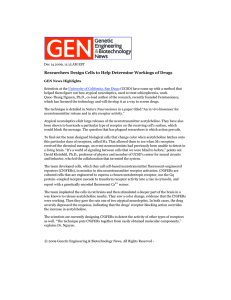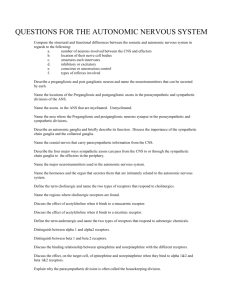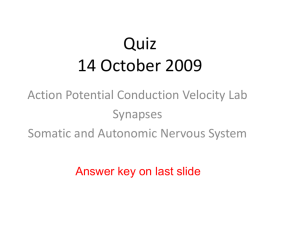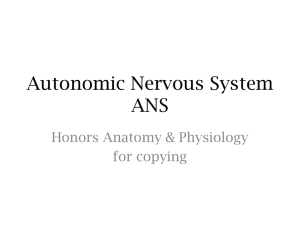Transmission in ANS
advertisement
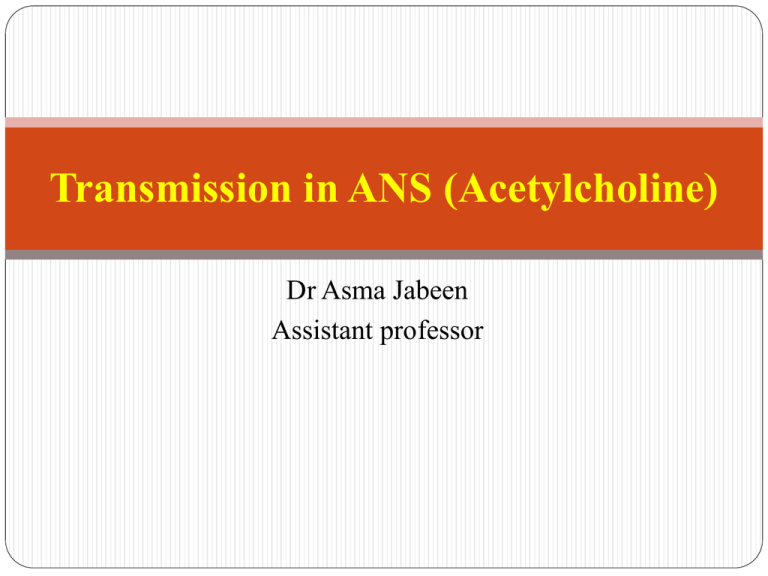
Transmission in ANS (Acetylcholine) Dr Asma Jabeen Assistant professor Learning Objectives At the end of this session, the student should be able to: •List the sites of release of acetylcholine as a chemical transmitter •Diagram the steps of acetylcholine synthesis •Describe the actions of acetylcholine and classify the cholinergic receptors according to these actions. •Discuss the mechanism of actions of acetylcholine. •Describe the removal of acetylcholine and the role of cholinesterase enzyme. Transmitters of ANS Acetylcholine -- parasympathetic transmitter. Nor epinephrine – sympathetic transmitter. Acetylcholine Otto Loewi (1903-1961) Born in Germany, American Citizen 1920 - Discovered 1st NT “Dreamed” the experiment Acetylcholine “vagus substance” 1936 - Nobel Prize ACh ACh ACh ANS neurotransmitters SOMATIC NERVOUS SYSTEM ACh Striated muscle AUTONOMIC NERVOUS SYSTEM Sympathetic ACh NE ACh ACh Heart Sm. mus. Glands Sweat, PILOERECTOR Glands,vasodilator SK; MUS; ACh Parasympathetic Ad. M. ACh E, NE ACh Heart Sm. mus. Glands Cholinergic fibers: All preganglionic fibers are cholinergic in both sympathetic and parasympathetic S. All or almost all postganglionic neurons of parasympathetic system are cholinergic. Postganglionic sympathetic fibers to sweat glands, piloerector muscle and and few blood vessels are cholinergic. Mechanism of transmitter secretion Postganglionic autonomic nerve endings are smaller than skeletal NMJ Mostly they end in connective tissue adjacent to the effector cell. They have bulbous enlargements at the ends called varicosities containing transmitter substance and lots of mitochondria. AP →Calcium diffusion into cell →release of transmitter from varicosities Synthesis and removal of acetylcholine Synthesized in terminal endings and vericosities of cholinergic nerve fibers. choline acetyltransferase Acetyl-CoA+ choline Acetylcholine Destruction: After a few sec. split into acetate ion and choline, catalyzed by acetylcholinesterase. A cholinergic synapse Choline Na+, Cl- Action potential Acetyl-CoA Acetyl-Choline Ca + + Ca + + Acetyl-Choline Mechanism of action The transmitter binds with specific receptor on the effector cells Receptor is on outside of a protein molecule that penetrates the membrane. This causes a conformational change in protein molecule Altered protein molecule excite or inhibit the cell by: Change of cell memb. permeability Activating or inactivating an enzyme e.g. Adenyle cyclase → CAMP Receptors in the parasympathetic system Nicotinic receptor Muscarinic receptor Neuroscience, Sinauer Asssoc., Inc Receptors of Autonomic nervous system General features Excitation and inhibition Acetylcholine Receptors: They are of two types: 1. 2. Muscarinic receptors Nicotinic receptors Muscarinic receptors: They are found on all effector cells stimulated by postganglionic cholinergic neurons of either parasympathetic or sympathetic system. Nicotinic receptors: Found in autonomic ganglia at synapses between pre and postganglionic neurons of both sympathetic and parasympathetic NS. Organs are usually innervated by both systems in opposing roles Receptors on the effector ions When the transmitter substance binds with the receptor, this causes a confirmational change in structure of the Protein molecule. In turn the alternate protein molecule Excite or inhibit the cell most often by: 1. Causing a change in cell membrane permeability to one or more ions 2. Activating or inactivating an enzyme attached to the other end of the receptor protein( adenyl cyclase - cAMP Effects of Sympathetic and Parasympathetic Systems Parasympathetic Action Organ Heart Action heart rate contractility AV node conduction Receptor M Gastrointestinal Tract motility relaxes sphincters M Bronchioles constricts M Male sex organs erection M Bladder contracts wall relaxes sphincter M Pupil constriction M Salivary glands skin secretion blood flow M M Autonomic Effects : Eyes Glands Blood vessels Heart Lungs Gut Liver Kidney Bladder Blood Basal metabolism Mental activity Fat cells Thank You
